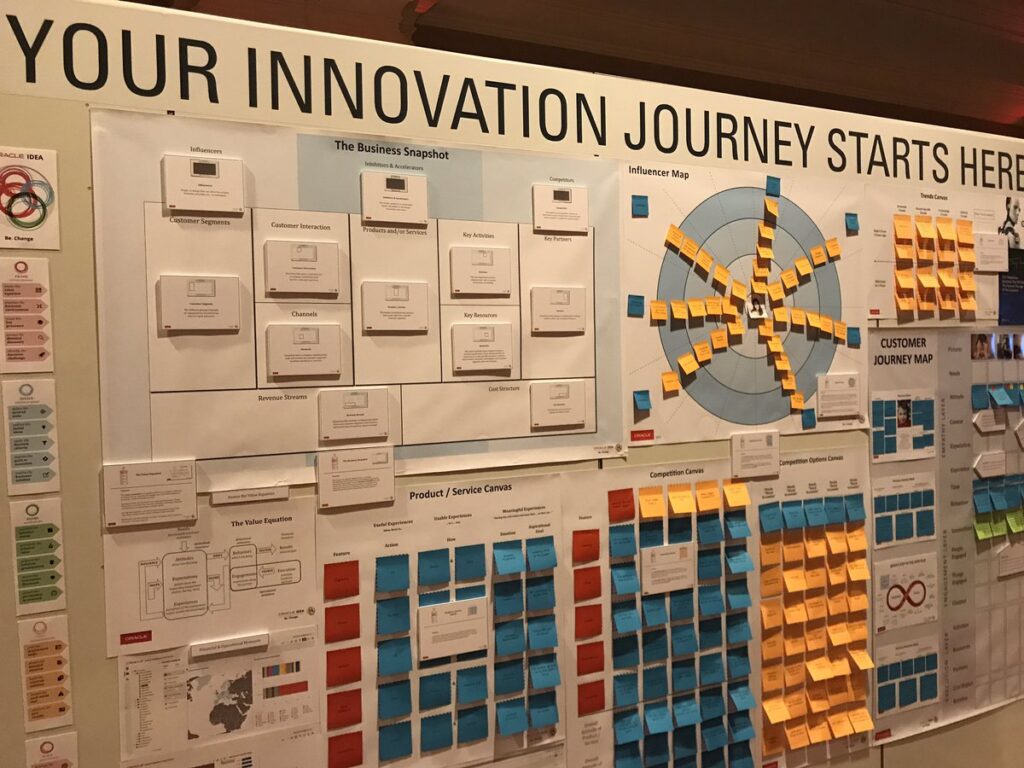A Customer Journey Map is the product of collaboration—between members of your marketing team and people in your company’s other functional areas.
But how do you know where to start? How do you keep the momentum going strong once it’s started? How can you make sure your Customer Journey Map is useful—and not just a nice-to-have project?
These best practices will help your marketing team create a useful Customer Journey Map.

Here are 10 best practices to consider as you get started:
1. Start with a clearly defined scope to ensure you have consensus on the project’s goals
Customer Journey Mapping is powerful because it gives marketing, sales, and customer service teams—as well as everyone else who interacts with customers—a shared understanding of how they can work together to deliver equal parts value and delight in every interaction.
But too often, Customer Journey Mapping works a little bit like a committee: we get together, talk about stuff and never seem to end up with much of anything useful.
As one professional marketer from our research tells us, “The Customer Journey Map gets shelved because the project felt overwhelming, or we didn’t have time.”
Often the result is that no one was happy—or that the Customer Journey Map was a waste of time.
To avoid these frustrations and make sure your team’s effort is productive, consider starting with an agreed-upon scope—including who will participate in the process, what you’ll map, and how far you’ll go down the path.
Negotiate this first step before you start to avoid any of the pitfalls that can pop up as you get started.
2. See your customer journey map as a conversation starter, not a project end point
Your Customer Journey Map likely will be the product of many meetings and constant communication over time.
And if people do their jobs well, it should reflect—and help to influence—how marketing, sales, and customer service teams work together to deliver exceptional experiences.
But don’t look for this map to be a solution in and of itself: it’s not a digital strategy or an online sales funnel or a customer service policy.
Your Customer Journey Map is just the beginning—and as you look at your map and find opportunities for improvement, keep those in mind as you move forward.
Keep your eye on the big picture, and focus on getting to “good enough” instead of aiming for perfection.

3. Start with where customers enter your business—and don’t think too small or too large
There are three questions you should consider when identifying where your journey begins: at what point do customers first interact with your company?
What is the most important product, service, or information you provide to them at that point?
And what should happen after they’ve interacted with you there—or before they even see that opportunity?
Look for opportunities to connect these dots across channels (web, social media, email) and mediums (print, TV, radio).
4. Consider how customers use your product or service throughout their journey—not just at any one point in time
Not every customer comes to you with the same mindset nor do they all leave that way.
If you consider each interaction as a stage along the path and focus on making sure each step is a positive experience, you’ll go a long way toward providing a great experience throughout.
5. Recognize that your customer’s journey is different than yours
We tend to focus on our own experiences, which makes it easy to forget how things look from the outside—from the point of view of customers we’re trying to serve.
A few years ago, I was working on an eCommerce PPC campaign and we decided to A/B test two versions of a new landing page.
The first version was more marketing-oriented, with the product featured prominently in the offer.
The second version focused on customer value—giving customers a sense of what they’d get out of the purchase, how it would help them, and what would happen if they decided to act.
The results were pretty surprising: version one had a conversion rate of 6%. Version two? 12%.
But here’s the really interesting part: we already knew that making the product more prominent would increase conversions—but when we looked at the data from a customer’s point of view, something different was happening.
The folks who saw version two told us that they liked the offer—but it didn’t solve their problem, which is what they’d come to solve on our site.
Their journey started with a problem and ended with an offer. We had asked them to make an emotional decision, not a rational one.

6. Don’t over-promise
Go easy on the adjectives like “world-class” or “exceptional” in favor of actionable items like “average wait time is only 2.5 minutes.”
And for goodness sake, avoid empty promises.
In an effort to be helpful but not fluffy, I made a list of things not to include in your journey map:
Don’t advocate for change. Instead, provide leaders with evidence of why things need to go a certain way.
Don’t clutter the canvas with too many elements. Pick three or five metrics that are really meaningful and actionable; otherwise, people will get lost in the weeds.
Don’t make it so easy to get the help that you take away the reason to do so.
Eliminate barriers like frequently asked questions instead of providing answers immediately where folks are already looking, like on Facebook or Twitter.
7. Use your customer’s voice—and theirs alone —to describe problems and opportunities
Data is great for discovery.
But when you’re crafting your map, it’s important to tell a story about why something is happening and how that situation could be improved, or what needs fixing.
Don’t use clunky phrases like “customer experience” or “happy customers.” And avoid passive phrasing, like saying “our brand has grown significantly.”
Let the data speak for itself without trying to oversimplify it.
8. Look at the whole picture—both digitally and physically
Look across channels, mediums, and interactions to glean insights about how people really experience your product or service in the real world.
And consider your company’s digital persona as well—what does the physical space look like?
Are there places where people are standing in line?
Are there materials on the tables?
What does that all mean for your brand?
9. Get help with your Customer Journey!
Don’t go it alone. Even if you’re an expert storyteller, set aside some time to meet with a professional storyteller (or two) who can help you distill your story and make it more easily digestible by others.
If you’re not a writer, find someone who can help you write it so that no single person is responsible for the final version.
Everyone’s got an opinion, but if there’s only one voice—yours or someone trusted—all other perspectives will be filtered through that lens.
And finally, loop in your cross-functional team: product, design, sales, and marketing to help them understand how their roles impact the customer experience.
10. Sell it!
When you’re done crafting your map, make sure you communicate its value—and don’t forget to invite collaborators into the conversation and keep them engaged.
Encourage them to reflect on where your product or service fits into the story you’re telling and what they can do to make it better.
Don’t be afraid to ask for input when it comes to turning that data into something actionable and meaningful.
Make sure everyone understands how their individual efforts connect—and support one another in making meaningful change happen.
Your journey map represents an opportunity to align your team around a single story.
Just be sure to frame the problem and layout your expectations before you embark on this journey together!
Good luck!

Ali is a digital marketing blogger and author who uses the power of words to inspire and impact others. He has written for leading publications like Business2Community, Inc. Magazine, and Marketing Profs. When not writing, he enjoys spending time with his family.
